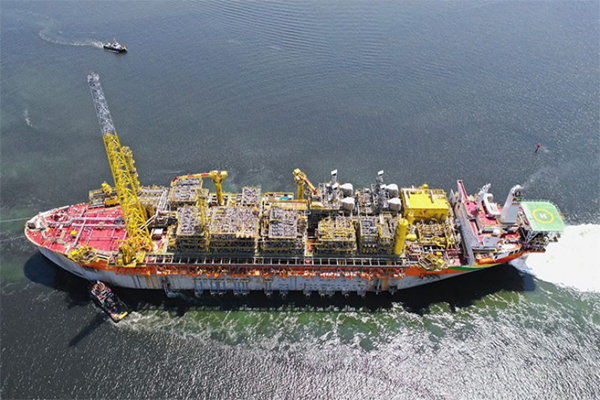- Tabs Uaru as fifth Guyana FPSO project
- Launching Baytown carbon capture, hydrogen project

Jordan Blum, Janet McGurty, Platts
HOSTON/NEW YORK
EnergiesNet.com 02 03 2022
ExxonMobil sees production volumes from the Permian Basin and offshore Guyana potentially combining for close to 2 million b/d of oil equivalent well before the end of the decade, according to its March 2 analyst day presentation, which compares to 3.8 million boe/d of total upstream production worldwide in the fourth quarter of 2021.
By 2027, ExxonMobil said its Permian, Guyana, Brazil and LNG production will represent well more than half of its global production volumes, and about 70% of its upstream capital spending, said Neil Chapman, ExxonMobil senior vice president.
ExxonMobil said March 2 it will make its Uaru discoveries offshore of Guyana its fifth FPSO project — slated to come online in 2026 with a capacity of more than 200,000 b/d. A to-be-determined sixth project is scheduled for completion in 2027.
The combined six projects would have a combined capacity of about 1.2 million boe/d, although ExxonMobil is conservatively only saying 2027 volumes will exceed 850,000 b/d. In reality, Chapman said production volumes thus far are exceeding expectations.
“It’s truly remarkable how far we’ve come in such a relatively short time,” Chapman said of the burgeoning oil industry in the small South American nation.
The first Guyana project, Liza Phase 1, began production in December 2019 with a capacity of 125,000 b/d. Liza Phase 2 just came online in February and is currently ramping up to its 220,000 b/d capacity. The 220,000 b/d Payara project would come online in 2024 and the 250,000 b/d Yellowtail development in 2025. ExxonMobil forecasts more than 10 billion boe of recoverable resources from its offshore Guyana block.
In the Permian, ExxonMobil plans to grow its 2021 volumes of 460,000 boe/d by 25% in 2022 and exceed 800,000 boe/d by 2027. Chapman said ExxonMobil expects to keep growing and eventually plateau at well more than 1 million boe/d from the Permian.
ExxonMobil’s production volumes trail Permian leaders Chevron and Pioneer Natural Resources — each already producing more than 600,000 boe/d from the basin — but ExxonMobil is safely within the next top tier along with Occidental Petroleum and ConocoPhillips, all of whom plan to exceed 500,000 boe/d in 2022.
Chapman said ExxonMobil is most prolific in the Poke Lake area of the Permian’s Delaware Basin in New Mexico. ExxonMobil is focusing on a “manufacturing” drilling and hydraulic fracturing approach with multi-well pad corridors that takes advantage of contiguous acreage to drill longer horizontal laterals with more frac stages.
He cited the ability to drill 1.5-mile laterals in roughly six days, as well as fracking a 5,300-foot lateral in just one day.
On the hop topic of the war in Ukraine and escalating sanctions against Russia, ExxonMobil CEO Darren Woods reiterated plans to exit Russia. ExxonMobil will discontinue operations at its large Sakhalin-1 oil and gas development offshore of Russia, while also avoiding new investments in Russia.
“Longer term then, given the direction the Russian government is taking, our view is we’ll exit the operations,” Woods said. “We’re on that journey and starting that process.”
Downstream
ExxonMobil is moving ahead with its Gulf Coast Permian processing project, which will increase light, sweet Permian crude processing capacity by 250,000 b/d at the Beaumont, Texas, plant.
The project, which was delayed during the coronavirus pandemic, would hike refined product output by 120,000 b/d, replacing the intermediates ExxonMobil had bought not only for Beaumont, but for its two other US Gulf Coast refineries in Baytown, Texas, and Baton Rouge, Louisiana.
ExxonMobil also is adding lower-emissions and carbon-reduction strategies to the Beaumont facility, planning to build a blue hydrogen plant to power the olefins plant and add carbon-capture storage to the facility, which ExxonMobil said would reduce emissions by about 30%.
ExxonMobil is the leader in CCS technology, Chapman said, adding the project is the “initial activation phase” of ExxonMobil’s larger plans towards establishing a “broad, cross-industry” Houston carbon capture and storage (CCS) hub able to store about 50 million mt/yr of CO2 by 2030, with volumes increasing to 100 million mt/yr by 2040.
In the biofuels space, ExxonMobil is aiming to produce 40,000 b/d of biofuels by 2025, which they see rising to 200,000 b/d of biofuels by 2030 as it focuses on markets with supportive policies in place, such as California, Canada and Europe, said Jack Williams, ExxonMobil senior vice president of products solutions.
This includes projects currently underway at its Strathcona refinery outside Edmonton, Alberta, which would produce 20,000 b/d of renewable diesel by 2024. The project includes blue hydrogen and CCS components, lowering the carbon intensity and raising the value of the products under Canada’s clean fuel regulations.
In California, ExxonMobil expanded its exclusive offtake agreement with Green Clean Energy in Bakersfield to take 5 million b/yr of renewable diesel made from camelina from the plant, which is expected to start up in 2022.
In Europe, by replacing old coking technology with advanced hydrocracking technology at the Rotterdam refinery, the plant would add 20,000 b/d of clean distillates. Modifications to the UK’s Fawley diesel hydrotreat and Singapore’s resid output plan to add 30,000 b/d and 50,000 b/d of clean distillates, respectively, to ExxonMobil’s production.
ExxonMobil also is considering repurposing existing assets to increase biofuel production while evaluating adding new assets to its portfolio as it sees demand for gasoline, distillates and fuel oil declining.
spglobal.com 93 02 2022












